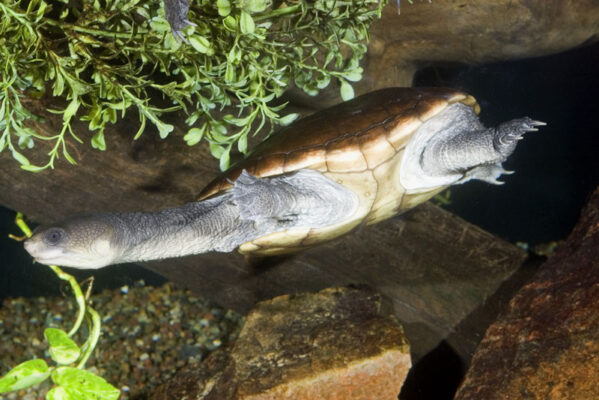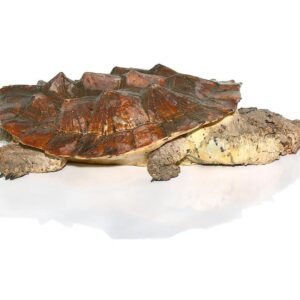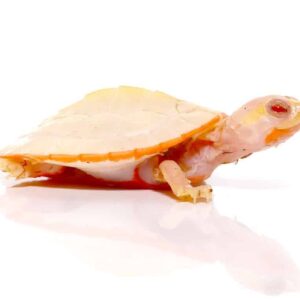Adult Reimanns Snake-Neck Turtle For Sale
$699.99
WE HAVE ADULT REIMANNS SNAKE-NECK TURTLE FOR SALE. HERE ARE SOME HIGHLIGHTS:
- Chelodina Reimanni
- Field Collected
- Approximately 5 – 7 Inches In Shell Length
- Adults Can Grow Up To 8 Inches
- Fascinating To Watch Swim & Feed On Blood Worms, Silversides, Turtle Pellets, And Shrimp
FUN FACTS!
- Amazing Creatures Displaying Long Pale Necks Able To Reach The Waters Surface
- Originating Out Of Southeast Asia These Turtles Live In Swamps And Marshy Habitats
- These Are Beautiful Turtles That Have Stunning Color On Its Body, Combined With Unique Patterns On Its Shell, That Are Coming To You With A Smile
Description
Reimanns Snake-Neck Turtle, scientifically known as Chelodina reimanni, is a unique and intriguing species within the chelonian family. One of the most distinctive features of this turtle is its exceptionally long neck, which bears a striking resemblance to that of a snake, giving the turtle its common name. Unlike many other turtles, the neck of Chelodina reimanni can be almost as long as its shell, allowing it to catch prey with remarkable agility and precision.
This turtle is primarily found in the freshwater habitats of Papua New Guinea and Indonesia. These regions offer the ideal environment for Reimanns Snake-Neck Turtle, with their slow-moving rivers, swamps, and ponds providing abundant food sources and shelter. The geographical distribution of this species is relatively limited, which adds to its uniqueness and the importance of understanding its ecology and conservation needs.
Physically, Reimanns Snake-Neck Turtle exhibits a broad, flattened shell that can vary in color from dark brown to olive green. The plastron, or the underside of the shell, typically showcases a lighter hue, often yellowish or cream-colored. The elongated neck is not just a physical marvel but also an evolutionary adaptation that aids in hunting and survival in its specific aquatic habitats. This adaptation allows the turtle to extend its reach significantly, making it a proficient predator of small fish, insects, and other aquatic invertebrates.
Understanding the general characteristics and natural habitat of Reimanns Snake-Neck Turtle is crucial for both enthusiasts and researchers. The unique blend of physical attributes and specialized habitat requirements underscores the importance of ongoing conservation efforts to protect this fascinating species and its environment.
Physical Characteristics
Reimanns Snake-Neck Turtle, known scientifically as Chelodina reimanni, presents a distinctive appearance that sets it apart from other species. One of the most notable features is its elongated neck, which can sometimes be as long as the carapace. This flexible neck allows for a greater range of movement, enabling the turtle to catch prey with remarkable agility. The neck’s length and flexibility are critical for their survival in their natural habitat, providing an evolutionary advantage in both hunting and defense.
The shell, or carapace, of Reimanns Snake-Neck Turtle is generally oval-shaped and moderately domed. Adult turtles typically exhibit a carapace length ranging between 20 to 30 centimeters. The shell’s coloration can vary, but it often displays shades of brown or olive, with some individuals showing darker or lighter hues. The plastron, or the underside of the shell, is usually lighter, often yellowish or cream in color, which provides a striking contrast to the darker carapace.
Sexual dimorphism is evident in Reimanns Snake-Neck Turtle. Males tend to have longer, thicker tails compared to females, which aids in identifying the gender. Additionally, males often possess a more concave plastron, while females have a flatter one, facilitating egg-laying. These differences are subtle but significant for those studying or breeding these turtles.
Another remarkable feature of Reimanns Snake-Neck Turtle is its webbed feet, which are well-adapted for an aquatic lifestyle. These webbed appendages, coupled with sharp, clawed toes, enable efficient swimming and maneuvering in water. The claws also assist in digging and foraging, making them versatile tools for survival.
Overall, the physical characteristics of Reimanns Snake-Neck Turtle not only highlight its unique adaptations but also emphasize its evolutionary success in various aquatic environments. Understanding these traits is essential for appreciating the biology and ecology of this fascinating species.
Habitat and Distribution
Reimanns Snake-Neck Turtle (Chelodina reimanni) is a fascinating species that thrives in specific freshwater habitats. These turtles are predominantly found in slow-moving rivers, swamps, and ponds, where the water conditions provide an ideal environment for their unique physiological and behavioral needs. Their preference for such habitats ensures they have access to ample vegetation and invertebrates, which constitute their primary diet.
The geographical distribution of Reimanns Snake-Neck Turtle is primarily concentrated in Papua New Guinea and Indonesia. Within these regions, the turtles can be spotted in various freshwater systems, from large river basins to smaller, isolated swamps. Their presence in these areas underscores the species’ adaptability to different freshwater environments, provided that the water flow is slow and there is sufficient cover from aquatic vegetation.
Environmental preferences for Reimanns Snake-Neck Turtle include a need for clean, oxygen-rich water and abundant submerged and floating vegetation. These conditions are crucial as they provide both shelter and feeding grounds. The turtles are particularly sensitive to changes in water quality and habitat disruption, which can have significant impacts on their populations. Consequently, conservation efforts in Papua New Guinea and Indonesia focus on preserving these critical habitats to ensure the survival of this unique species.
Understanding the habitat and distribution of Reimanns Snake-Neck Turtle is vital for conservationists and researchers aiming to protect and study this species. By maintaining the integrity of their natural habitats and monitoring environmental changes, we can help safeguard the future of these distinctive turtles in their native regions.
Diet and Feeding Habits
Reimanns Snake-Neck Turtle, known scientifically as Chelodina reimanni, exhibits omnivorous dietary preferences that are crucial to its sustenance and overall health. This species primarily thrives on a varied diet, consisting of aquatic insects, small fish, and diverse plant materials. The combination of these food sources ensures that the turtle receives a balanced intake of proteins, fats, and essential nutrients necessary for its growth and energy requirements.
Aquatic insects form a significant part of the turtle’s diet, providing essential proteins that are critical for their growth and maintenance. Small fish are another vital component, offering both protein and fat. The inclusion of plant materials such as algae, aquatic plants, and occasionally fruits ensures the intake of necessary fibers and vitamins, contributing to the turtle’s digestive health.
One of the most fascinating aspects of Reimanns Snake-Neck Turtle is its unique hunting technique, facilitated by its elongated neck. This physical adaptation allows the turtle to execute swift and precise strikes, capturing prey with remarkable efficiency. The turtle’s long neck extends rapidly to snatch unsuspecting prey, which is vital for catching agile and elusive aquatic insects and small fish. This predatory behavior underscores the turtle’s adeptness at securing food in its natural habitat.
In captivity, it is essential to replicate these dietary habits to maintain the turtle’s health and well-being. A balanced diet that mimics their natural food sources should be provided, including commercially available turtle pellets, live or frozen fish, and a variety of vegetables. Ensuring a diverse diet not only promotes physical health but also stimulates natural hunting behaviors, which are important for the turtle’s mental stimulation and overall quality of life.
Understanding the dietary preferences and feeding behaviors of Reimanns Snake-Neck Turtle is integral for both conservation efforts and responsible pet ownership. By providing a diet that closely aligns with their natural food sources, caretakers can ensure these remarkable reptiles thrive in both wild and captive environments.
Behavior and Temperament
Reimanns Snake-Neck Turtle, a unique and fascinating species, exhibits distinct behavior and temperament traits. These turtles are primarily diurnal, meaning they are most active during the day. They spend a significant portion of their daylight hours basking on rocks or logs and foraging for food. Their activity patterns are closely linked to their need for thermoregulation, as they rely on external heat sources to maintain their body temperature.
Socially, Reimanns Snake-Neck Turtles are relatively solitary creatures. They do not exhibit strong social bonds and generally prefer to keep to themselves. However, in environments where they share space with other turtles, they can be observed engaging in mild interactions, mostly related to competition for basking spots or food. These interactions seldom escalate into aggressive behavior, as these turtles tend to be more passive.
When it comes to interactions with other species, Reimanns Snake-Neck Turtles are typically non-confrontational. They often ignore other animals unless they perceive them as a threat. When faced with potential dangers, their primary defensive behavior involves retracting their neck into an S-shape and secreting a foul-smelling musk to deter predators. This defense mechanism is quite effective, as the odor can be highly repulsive.
In captivity, these turtles may become more accustomed to human presence over time, displaying a calm and docile demeanor. However, they should be handled minimally to reduce stress and avoid unnecessary defensive behaviors. Understanding the natural behavior and temperament of Reimanns Snake-Neck Turtle is crucial for providing them with a suitable environment that mimics their natural habitat, ensuring their well-being and promoting healthy interactions.
Reproduction and Lifespan
Reimanns Snake-Neck Turtle exhibits fascinating reproductive behaviors that are indicative of its adaptability and survival strategies. During the breeding season, which typically occurs in the warmer months, males engage in a series of courtship behaviors to attract females. These behaviors often include tactile interactions and gentle bites, aimed at garnering the female’s attention. Once mating is successful, the female will seek an appropriate nesting site to lay her eggs.
Nesting sites are usually located in sandy or loamy soils close to water sources, ensuring the optimal environment for egg incubation. The female can lay a clutch of 10 to 20 eggs, which she carefully buries in a nest dug with her hind limbs. The incubation period for the eggs varies depending on environmental conditions, particularly temperature, but generally spans between 60 to 90 days. During this time, the eggs are highly susceptible to predation and need to be well-concealed to enhance the chances of hatchling survival.
Hatchlings emerge from the nests and instinctively make their way to the nearest water body, where they begin their independent lives. Unlike many other species, Reimanns Snake-Neck Turtle hatchlings receive no parental care post-hatching, relying solely on their innate survival instincts. The juvenile turtles are vulnerable to predators and environmental challenges, making the early stages of life particularly perilous.
The lifespan of Reimanns Snake-Neck Turtle varies between natural habitats and captivity. In the wild, these turtles can live up to 30 years, though this is contingent upon numerous factors including predation, food availability, and habitat stability. In captivity, where threats are minimized and care is optimized, they can live beyond 40 years. This extended lifespan in captivity contributes significantly to the species’ conservation, providing opportunities for study and breeding programs aimed at sustaining their populations.
Conservation Status
Reimanns Snake-Neck Turtle (Chelodina reimanni) is currently classified as a vulnerable species, primarily due to significant threats that jeopardize its population. Habitat destruction stands as a predominant factor. The natural habitats of these turtles are often compromised by human activities such as deforestation, agricultural expansion, and urbanization. The degradation of wetland ecosystems, essential for their survival, contributes heavily to the decline in their numbers.
Pollution further exacerbates the situation. Contaminants like pesticides, heavy metals, and industrial waste infiltrate their aquatic environments, leading to deteriorating water quality. These pollutants not only affect the turtles directly but also diminish the availability of their prey, thereby impacting their food sources.
Another significant threat comes from the illegal pet trade. Due to their unique appearance and exotic allure, Reimanns Snake-Neck Turtles are targeted by wildlife traffickers. This illicit trade reduces the wild population and disrupts the species’ natural reproductive cycles.
In response to these pressing threats, various conservation efforts have been initiated. Protective measures include the establishment of protected areas and sanctuaries that offer a safe haven for the turtles. Additionally, stringent regulations and enforcement against illegal trade are in place to curb wildlife trafficking. Environmental organizations and government bodies actively collaborate to monitor and safeguard these protected zones.
Moreover, several non-governmental organizations (NGOs) play a pivotal role in conservation efforts. Organizations such as the World Wildlife Fund (WWF) and the Turtle Conservation Fund (TCF) are deeply involved in research, habitat restoration, and public awareness campaigns. These initiatives aim to educate local communities and the general public about the importance of conserving Reimann’s Snake-Neck Turtle and their habitats.
Through continued conservation efforts and heightened awareness, there is hope for stabilizing and eventually increasing the population of this vulnerable species, ensuring their survival for future generations.
Caring for Reimann’s Snake-Neck Turtle in Captivity
Reimann’s Snake-Neck Turtle, scientifically known as Chelodina reimanni, is a fascinating species that can be kept successfully in captivity with proper care. The first step in ensuring the well-being of your turtle is setting up an appropriate habitat. A spacious tank is essential; a minimum of 40 gallons is recommended for a single adult turtle. The tank should include both a land area for basking and a water section deep enough for swimming. An efficient filtration system is crucial to maintain pristine water quality, as poor conditions can lead to health issues.
Water temperature should be maintained between 75-80°F, while the basking area should be slightly warmer, around 85-90°F. Use a submersible heater and UVB lighting to replicate the turtle’s natural environment. UVB lighting is particularly important, as it helps in the synthesis of vitamin D3, which is vital for calcium absorption and shell health.
The diet of Reimann’s Snake-Neck Turtle should be varied and balanced. In the wild, they are omnivores, feeding on fish, invertebrates, and aquatic vegetation. In captivity, you can provide a mix of commercial turtle pellets, live or frozen fish, insects, and leafy greens. Supplement their diet occasionally with calcium and vitamin D3 to prevent deficiencies.
Regular health checks and veterinary care are necessary to keep your turtle healthy. Monitor for signs of illness, such as lethargy, lack of appetite, or abnormal shell appearance. If any symptoms are observed, consult a reptile veterinarian promptly.
Handling Reimann’s Snake-Neck Turtle should be done with care. They can be stressed easily, and rough handling can lead to injury. Limit handling to essential activities such as tank cleaning or health checks. Socialization is minimal, as these turtles are generally solitary. However, ensuring a stress-free environment by providing hiding spots and a stable routine can promote a healthier life.
By adhering to these guidelines, you can create a nurturing and stable environment for your Reimann’s Snake-Neck Turtle, ensuring it thrives in captivity.






